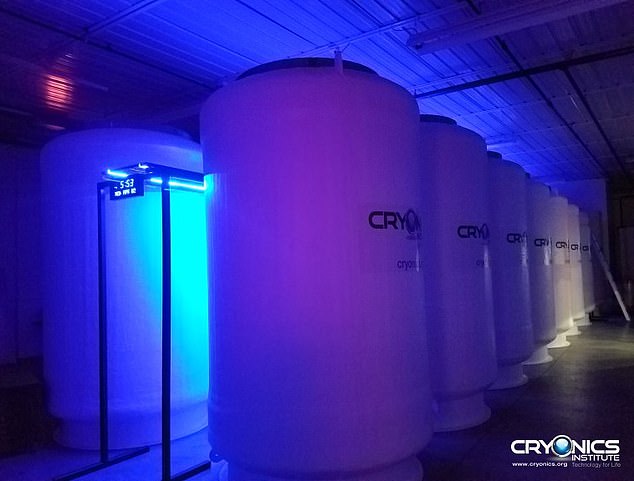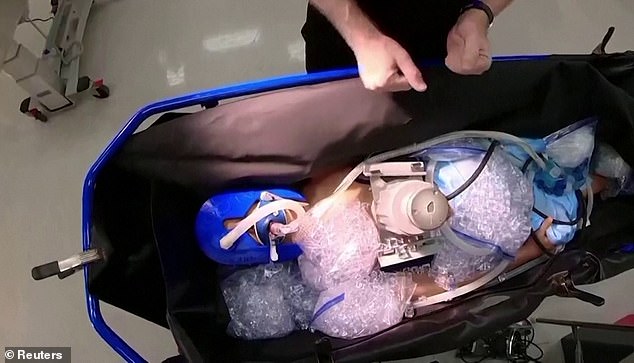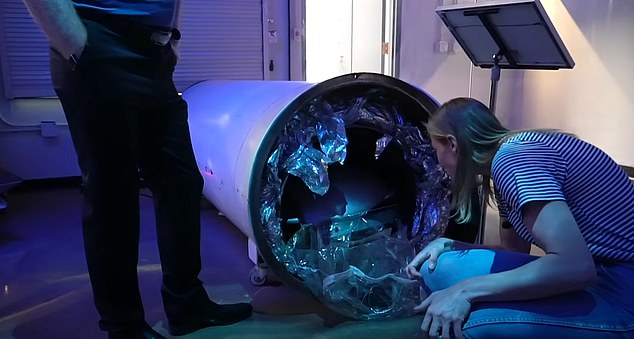Michigan’s low-cost cryogenic lab freezes hundreds of patients’ bodies for just $28,000 until science can bring them back to life — and business is booming
Chefs, students, secretaries, professors and pets are among those stored in liquid nitrogen at the Cryonics Institute
A growing number of people – and pets – are being frozen in cryogenic labs, hoping to one day be brought back to life if science catches up.
Business is booming at the Cryonics Institute laboratory in Michigan, keeping it at capacity and forcing patients to be stored in a new center nearby.
Between 10 and 20 places have been taken in the extensive storage facility.
What was once the crazy idea of Walt Disney and the ultra-rich elites is becoming increasingly accessible to ordinary people.
At the Michigan facility, chefs, students, secretaries, professors and pets, among others, are stored in liquid nitrogen.
The center prides itself on being affordable to the average person with full body preservation starting at $28,000, which is usually paid for through life insurance.
Cryonics – the practice of deep-freezing the bodies of dead people – is a worldwide phenomenon. While 1,374 of the 1,975 patients stored at the Michigan facility are American and 128 are British, according to membership statistics released by the institute.
Another well-known freeze location in America is the Alcor Life Extension Foundation in Arizona.
From the outside it looks like any other warehouse. But inside lie the frozen dead bodies of hundreds of patients.
It’s on the pricier side: It costs people $200,000 to have their entire body stored in a high-tech freezer, but there is an option to put just the brain on ice for a discounted price of $80,000.
So far, 199 deceased remains have been stored there, kept fresh thanks to liquid nitrogen that keeps the bodies at -275 degrees Fahrenheit — a temperature so cold that all cell functions are halted and their condition is preserved until they thaw.

The longest-running patient at the Cryonics Institute, named Rhea Ettinger, has been there since 1977

The number of patients at the Cryonics Institute in Michigan has grown from approximately 600 in 2006 to almost 1,900 in 2021
The number of patients at the Michigan center has grown dramatically from about 600 in 2006 to nearly 1,975 in 2023.
The longest-running patient, named Rhea Ettinger, has been there since 1977.
Her son, Robert Ettinger, a World War II veteran and founder of the Cryonics Institute, is also in the Arctic limbo, along with his first and second wife.
Dennis Kowalski, president of the Cryonics Institute, said, “Ironically, even though our membership is growing, I’m just surprised we’re not more popular.
‘What we do is quite rational when you think about it. Cryonics is like an ambulance ride to a future hospital that may or may not ever exist.
‘Although we make no guarantees, the chances of coming back are zero if you are buried or cremated.
‘So we are Pascal’s bet, or a gamble where there is little to lose and everything to gain.’
In the main warehouse, about 250 ‘cryostats’ are lined up in rows. These are devices used to maintain low freezer temperatures.
Mr. Kowalski told it Metro.nl that the Cryonics Institute is the largest cryonics company in the world, with the most patients frozen in time.

Of the total 1,975 patients stored at the Michigan facility, 1,374 are American and 128 are British, according to membership statistics released by the institute

Patients are stored at –321F in rooms used to maintain low freezer temperatures
The center is located in Clinton Township, Michigan, which is also a farming community.
Mr Kowalski said: ‘We are affordable to the average person through life insurance and we are not for profit, with all our data open to public scrutiny.’
Of the total 1,975 patients stored at the Michigan facility, 1,374 are American and 128 are British, according to membership statistics released by the institute.
It is also home to 253 frozen pets.
Once patients (or pets) are declared medically dead, they are placed on ice and transported to the new facility.
This is where a perfusion takes place (when a fluid is passed through the circulatory system) to replace the patient’s blood and water with a special cryoprotection mixture that stops ice formation.
The fluid acts as a form of antifreeze at super low temperatures.
The patient is then placed in a computer-controlled unit that is cooled to a liquid nitrogen temperature of –321F for five and a half days before being lowered into the cryostat.
Even as scientists figure out how to bring people back to life, they would also have to figure out how to reverse the aging process and the condition that caused them to die.
Dr. Miriam Stoppard, journalist, doctor and critic of cryogenics, previously said the practice “deprives the dying of their dignity.”

When a person dies, their body is frozen to cool and all blood and other fluids are removed so that they do not crystallize and damage the body’s cells during storage.

A dummy placed where a body would be while it is being prepared for storage

An open cylinder that can be used to store a person’s body or brain after his or her death
People who invest in these services are often desperate to be reunited with family in the future.
The youngest known patient at the Arizona institute is a two-year-old Thai girl who died of brain cancer. Her family hopes to be reunited with her later.
But cryogenic freezing also attracts the rich and eccentric. Bitcoin pioneer Hal Finney chose to have his body cryopreserved at Alcor after dying in 2014 from complications related to ALS.
But there are serious ethical and moral concerns about the practice that has been touted for decades but remains a pipe dream.
Max More, CEO of the company, admitted during an interview in February 2020 that his company does not know when the technology necessary to wake their patients will exist.
The high prices of this maintenance can often deplete a person’s assets, and will often consume a large portion of their life insurance payout – which could instead have benefited their family later.
To become an Alcor member, a person must pay an annual fee of more than $200 and be over 18 years of age. The costs increase with the age at which someone wants to register.
A non-member whose loved ones want them frozen must add another $20,000. If a person dies outside the US or Canada and their remains need to be collected, an additional $10,000 will be added.
